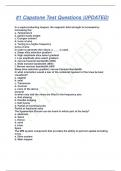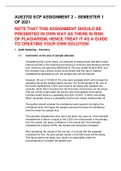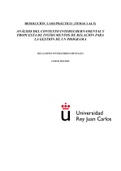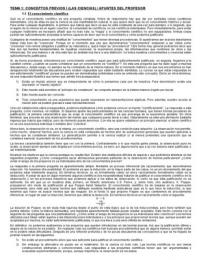The characteristics of persistent sexual offenders: a meta -analysis of recidivism
studies. Hanson, & Morton-Bourgon, (2005).
Recidivism refers to the tendency of a convicted criminal to reoffend. The sexual recidivism rate (for
sexual offenders) is typically 10% to 15% after 5 years.
Base rate = prior probabilities, population proportions, or information about central
tendencies in the outcome domain. E.g. recidivism rates in sex offenders
Sexual recidivism is associated with: (a) deviant sexual interests and (b) antisocial
orientation/lifestyle instability.
- Deviant sexual interests refer to lasting attractions to acts that are illegal (e.g. sex with
children, rape) or highly unusual (e.g. fetishism, autoerotic asphyxia).
- Antisocial orientation refers to antisocial personality, antisocial traits (i.e. impulsivity,
substance abuse, unemployment) and a history of rule violation.
o Antisocial orientation facilitates sexual offending as individuals will not commit sexual
crimes unless they are (a) willing to hurt others, (b) can convince themselves that they
are not harming their victims, or (c) feel unable to stop themselves.
There may be three additional characteristics of persistent sexual offenders: (a) negative family
background, (b) problems forming affectionate bonds with friends and lovers, and (c) attitudes tolerant
of sexual assault.
There is a difference between static factors and dynamic risk factors. Static factors are useful for
predicting long-term recidivism. Dynamic risk factors are useful for understanding (and changing)
recidivism risk.
The aim of risk assessment is to obtain insights into heterogenous groups of offenders. This is based
on information regarding risk factors that are related to recidivism.
Static risk factors Dynamic risk factors
• Historical Stable
• Unchangeable • Stable personality traits (e.g., impulsivity)
• Scoring: reliable, quick, and simple • Change = possible, but slow
• Predictive validity Acute
• Change = possible, and fast (e.g. access to
drugs and alcohol)
In this article, a meta-analysis of 82 recidivism studies was performed. This
meta-analysis had several findings:
- Strong predictors of sexual recidivism we re: (a) sexual deviancy, (b)
antisocial orientation. This was the same for both adults and
adolescents. (see above)
- The major predictor of violent non-sexual recidivism, violent
(including sexual) recidivism and any recidivism was antisocial
orientation. This was the same for both adults and adolescents.
- Strong predictors of any recidivism were: (a) general problems with
self-regulation, (b) a history of nonviolent crime, (c) psychopathy,
and (d) a history of nonsexual crime.
- Possible dynamic risk factors: (1) variables related to sexual deviancy (any deviant sexual
interest, sexual preoccupations), (2) antisocial personality (antisocial personality disorder,
psychopathy), and (3) antisocial traits (general self-regulation problems, employment
instability, hostility).
Page 1 of 22
, - Potentially misleading risk factors (????): (1) negative family background, (2) internalization of
psychological problems, and (3) poor clinical presentation (e.g. denial, low motivation for
treatment).
- Most sexual offenders were not caught for another sexual offence (13.7%), they were more
likely to recidivate with a nonsexual offence than a sexual offence (overall recidivism rate of
36.2%).
- Negative family backgrounds and internalization of psychological problems are common among
sexual offenders, but these factors were unrelated to sexual recidivism.
- Many of the variables used in clinical assessments had little or no relationship with recidivism
(e.g. denial, low victim empathy, low motivation for treatment).
-
The use of the HCR-20V3 in Dutch forensic psychiatric practice.
de Vogel, van den Broek, & de Vries Robbé (2014).
Risk assessment = assessing the risk of future violent and/or non-violent behavior. Estimating the
likelihood that someone will exhibit certain behavior (usually aggressive behavior or sexual
offenses) in the near or distant future. Main question: will they do it again?
Structured violence risk assessment tools can:
1. Provide insight into risk and protective factors,
2. Provide concrete guidelines for risk management and treatment. This helps to prevent violent
recidivism (reoffending)
3. Determine the most appropriate security level,
4. Help with developing and evaluating treatment strategies that reduce violence risk
5. Help to communicate in a better and more transparent way in treatment settings and between
different institutions
The Structured Professional Judgment approach (SJP) is aimed at systematically collecting, reviewing,
combining, weighing, and integrating information on risk factors. According to the SPJ approach, the
most widely used risk assessment instrument for the assessment of risk for future violence is the
Historical, Clinical, Risk management-20 Version 2 (HCR-20, 1997). In 2013 the revised version of the
HCR-20 was published: the HCR-20V3. This article discussed the applicability of the HCR-20V3 for
violence risk assessment in forensic psychiatric practice.
In the Netherlands, all forensic psychiatric institutions are mandated to perform structured risk
assessment (with the HCR-20 or HKT-30), before deciding upon leaves or discharge of all forensic
patients, who have been sentenced to mandatory treatment. A TBS-order is a Dutch court-order
implying mandatory inpatient psychiatric treatment. The main goal of this mandatory treatment is to
reduce violence risk.
The seven steps of the HCR-20V3:
Step 1. Case information. Information is
gathered from clinical and judicial
files, including collateral information
from different sources, such as
family members.
Step 2. Presence of risk factors
Step 3. Relevance of risk factors
Step 4. Risk formulation. Risk formulation is
intended to facilitate the clinician’s
conceptualization of the roots of a person’s problems with an eye toward intervention.
Formulation requires evaluators to integrate the separate risk factors (step 2 and 3) into
a conceptual meaningful framework that explains a person’s violence.
Page 2 of 22
, Step 5. Risk scenarios. Risk scenarios are used to make the final bridge to risk management.
They represent future oriented formulation – what might a person do in the future, and
why?
Step 6. Management strategies. The Risk-Need-Responsivity (RNR) model (see below) can be
helpful in integrating step 2, 3, 4, and 5 into a proper risk management plan.
Step 7. Conclusory opinions. In the final step, conclusions can be drawn about the client’s SSRs.
Risk-Need-Responsivity (RNR) model:
a. The Risk principle states that high risk cases should receive high intensity risk management,
whereas low risk cases should receive management of lower intensity.
b. The Need principle holds that management efforts should target dynamic risk factors that are
considered important for lowering the risk for a specific patient (criminogenic needs)
c. The Responsivity Principle dictates that programs should be delivered in a manner that matches
the learning styles of those receiving them. In general, it is recommended to work with
structured, cognitive-behavioral and social learning approaches.
According to this model, the aim of treatment (rehabilitation) should be on avoiding that additional
damage is done to society (recidivism) ~ risk management. Well-being and general functioning are of
‘secondary’ importance.
a. Risk principle – who should receive the most intensive treatment?
• Low risk -> supervision, no treatment
• Medium risk -> forensic outpatient treatment
• High risk -> forensic inpatient treatment & treatment during imprisonment
Placing low-risk individuals in a high-risk environment (inpatient treatment) leads to them becoming a
higher risk, because of:
- Influence of antisocial peers
- Impact on protective factors
- Manipulation by high-risk groups
b. Need principle – what should the focus of the treatment be? (risk factors)
• Criminogenic needs are characteristics, traits, problems or issues of an individual that
directly relate to the individual’s likelihood to re-offend and commit another crime.
o Non-criminogenic factors are factors that are not related to recidivism but are hampering
for example the well-being of the offender. These can also be treated but should not be the
focus of the treatment.
• Assessment: risk assessment tools!
• Hence, the outcome of risk assessment should include advice regarding the criminogenic
needs
c. Responsivity principle – How can the treatment be adapted to the individual?
• Learning style = taking into regard the (dis)abilities of the offender (e.g. low affect, low IQ)
• Motivation = changeable (first get a patient motivated before starting the treatment)
• Psychiatric disorders: usually a responsivity factor, often not a risk factor (especially in sex
offenders)
Four basic activities:
a. Monitoring/Surveillance. The goal of monitoring is to evaluate changes in risk over time so that
risk management strategies can be revised when needed. Monitoring, unlike supervision,
focuses on surveillance rather than control or restriction of liberties.
b. Treatment. The goal of treatment is to improve deficits in the individual’s psychosocial
adjustment or functioning.
c. Supervision. Supervision involves restrictions of the individual’s rights and freedoms. The goal
of supervision is to make it (more) difficult for the individual to engage in further violence.
d. Victim Safety Planning. Victim safety planning involves improving a potential victim’s (dynamic
and static) security resources, a process sometimes referred to as “target hardening”.
Page 3 of 22










